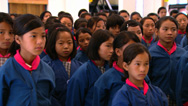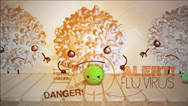A History of Vaccination
- By Ari Daniel
- Posted 09.05.14
- NOVA
Vaccines are often seen as a marvel of modern medicine. Surprisingly, the history of vaccination extends back centuries. This animated sequence details the intriguing history of vaccination, beginning more than a millennium ago.
Transcript
A History of Vaccination
Posted: September 5, 2014
Narrator: As surprising as it may seem, vaccination began as a type of traditional therapy at least 1,000 years ago.
In India, when a wave of smallpox approached a town, there are tales of people doing something extraordinary—they were lining up to actually buy the disease. The healers, known as Brahmins, would take a cloth and rub the person's upper arm. Then they would scratch the skin, just enough to draw blood. They would then apply dried smallpox scabs, taken from patients who had survived the disease.
Most people would get sick, but recover and from that point on, they were protected. Over 1,000 years ago, the Brahmins had observed one of the basic principles of immunity—that you rarely get infected twice.
Dr. Paul Offit:⨠We've got to give people credit. I mean, they got it right. They knew that there was something going on, that protected you—they just had no idea what it was or why.
Narrator: This early form of inoculation was called "variolation." Some say it originally came from Africa, others believe it began as an ancient form of Chinese medicine, where the powder of dried smallpox scabs was blown up the nose.
Dr. Peter Fisher:⨠We know that as early as 1000 AD, the Chinese were using variolation, using smallpox to prevent smallpox. And they were using some very advanced techniques actually what we would now call, you know, techniques you could recognize in modern virology.
Narrator: Importantly, they always used a weakened form of the disease.
Fisher:⨠They would select out the mild cases. And they would collect the lymph and put it in a vial and let it dry out and carry it in their pockets for two or three weeks, so you got at least a semi-killed vaccine. The viruses were, if not dead, certainly moribund.
Narrator: From the Brahmins in India, we fast-forward around 700 years to Europe, where over 400,000 people were dying from smallpox every year.
An English mother, Lady Mary Wortley Montagu, had only just survived smallpox and she desperately wanted to protect her children. Whilst in Constantinople, she wrote of seeing a practice unheard of in English medicine.
Voiceover: The old woman comes with a nutshell full of the best sort of small pox and asks what vein you please to have opened. She immediately rips open that you offer to her, which gives you no more pain than a common scratch and puts into the vein as much matter as can lie upon the head of her needle.
Narrator: Like the Brahmins, the local women practiced a form of folk medicine, handed down through generations.
Voiceover: The children play together all the rest of the day. Then the fever begins to seize them, and they keep their beds two days, very seldom three. And in eight days time, they are as well as before their illness.
Narrrator: Lady Mary inoculated her own son, providing him with something remarkable—immunity.
Offit: People knew that if you fought a particular disease and you survived it and you were immune for the rest of your life, that was a good thing. So people tried to figure out how can they essentially simulate that infection without really causing suffering and death, but still inducing the immunity that comes from that.
Narrator: Lady Mary brought the technique back to England, where it was widely accepted. They didn't understand why it worked, and it was never risk-free. But the death rate with wild smallpox was around 30%. With variolation, it dropped to 2%.
Fast forward another 70 years to an English doctor called Edward Jenner, who took the next vital step. He proved that deliberate infection with a mild, non-fatal disease—called cowpox—would protect against smallpox. He called his technique "vaccination," from vacca, Latin for cow.
Fisher:⨠The one thing that Jenner discovered was that vaccinia, or cowpox, which is generally a very mild disease in humans cross reacts—it prevents smallpox. It was his only discovery, an important discovery, but people think that he invented the whole idea, which he didn't.
Credits
- WRITTEN, DIRECTED AND PRODUCED BY
- Sonya Pemberton
- EDITOR
- Mark Atkin A.S.E.
- DIRECTOR OF PHOTOGRAPHY
- Harry Panagiotidis
- NARRATOR
- Rachael Blake
- LINE PRODUCER
- Roslyn Walker
- ASSOCIATE PRODUCER
- Harry Panagiotidis
- ASSOCIATE PRODUCER/2ND UNIT DIRECTOR
- Faye Welborn
- PRODUCTION COORDINATOR
- Sally Storey
- SOUND RECORDISTS
- Martin Keir
- RESEARCHERS
- Florienne Loder
James Shirvill - ARCHIVE RESEARCHER
- Nora Niasari
Supported by SBS/Film Victoria Traineeship Program - SCIENTIFIC ADVISORS
- Robert Booy
Julie Leask
NCIRS, University of Sydney Jenny Royle - SOUND DESIGNER
- Tristan Meredith
- ANIMATION AND VISUAL FX
- 21-19
- CREATIVE DIRECTOR
- Domenico Bartolo
- PRODUCER
- Julie Schroder
- DESIGNERS/ANIMATORS
- Domenico Bartolo
Ashley Millott
Stephen Elliget
Patrick Da Cunha - ADDITIONAL EDITING AND ONLINE EDITOR
- Wayne Hyett
- COLORIST
- Vincent Taylor
- ASSISTANT EDITOR
- Lucy Paplinska
- ACCOUNTANTS
- Bronwyn Speziale
Carol Ramirez - LEGAL ADVISOR
- Katie Shortland
- HEAD OF PRODUCTION (CJZ)
- Toni Malone
- ORIGINAL MUSIC
- Peter Dasent
© 2013 Origin Music Publishing (APRA)
Piano: Peter Dasent
Viola: James Eccles
Cello: Oliver Miller
Double Bass: Jonathan Zwartz
Percussion: Fabian Hevia
Vocals ("Frere Jacques"): Coco Dasent
Music Recorded and Mixed by Robin Gist - ADDITIONAL MUSIC
- "You Are The One"
Written and Performed by Darren Percival © 2012 Darren Percival
Darren Percival appears courtesy of Universal Music - ARCHIVE
- L'Oreal Women in Science footage
Directed by Alexandre Auvigne, Courtesy of Phénomène, France
The Mutter Museum
CriticalPast
Eli Lilly
CDC/Mary Hilperthauser/Stafford Smith
Prelinger Archives
CNN India
Bentley Reference Library
Measles photo by Julian Harneis
Bibliothèque de L'Académie Nationale de Médecine
From USA Today, a division of Gannett Co., Inc. Displayed with Permission
EUFA
Indian footage by Davor Dirlic - AUSTRALIA
- Osman Chandab and family, Luke Philbin and family, Sir Gustav Nossal,
Dr Daryl Efron, Prof Ingrid Scheffer, Prof Mark Kendall, Prof Sam Berkovic,
Prof Peter Doherty, Prof Peter McIntyre, Vanessa Whatmough,
Royal Children's Hospital Melbourne, Sangay Jamthso, Tony Wright, December Media,
Harriet James, Suhasini Seelin, Catherine Marciniak,
Ilias Panagiotidis, Toni and Dave McCaffery and family,
Elisa Hill and family, Camille Perry, Celeste Perry, Yolanda Atkin,
Darren Percival, Niall Byrne, Science in Public - BHUTAN
- Her Majesty The Royal Grand Mother, Ashi Kesang Choden Wangchuk,
Her Royal Highness, Ashi Kesang Wangmo Wangchuk,
Dorji Om and family, Prof Ian Frazer and Caroline Frazer,
Dr Kunzang Getshen, Dr Ugyen Tshomo,
Joe Tooma, Australian Cervical Cancer Foundation,
staff and students of the Khasadropehu Middle School - EUROPE
- Kristina Leatherbarrow and family, Victoria McBride and family,
Prof Bertie Squire, Dr Heidi Larson, Dr Peter Fisher,
Dr Nicholas Beeching, The Royal Liverpool University Hospital,
Joe Keenan, Dr Victor Yursa, Gleb Maleyev - UNITED STATES
- David Salamone and family, Gordon Pierson and family, Carol Spivey,
Shannon Duffy and family, Dr Brian Zikmund-Fisher and Eve Zikmund-Fisher,
University of Michigan, Dr Paul Offit, Mutter Museum and staff, Karie Youngdahl,
Pastor Becca Krogstad, Randazzo Dance School,
Edward J Eberwine III, Ellen Shire - The Peterson family are supported by PK Kids Online, www.pkids.org
- INVESTMENT MANAGER, SCREEN AUSTRALIA
- Mary-Ellen Mullane
- SBS COMMISSIONING EDITOR
- John Godfrey
- Developed with the Assistance of Film Victoria Australia
- Developed and Produced in Association with
SBS, National Documentary Program, Australian Government, Screen Australia - EXECUTIVE PRODUCERS
- Michael Cordell
Nick Murray
Sonya Pemberton - ©2013 Genepool Productions, Screen Australia & SBS Corporation
- In memory of Dorji Om
2013, Bhutan
IMAGE:
- Image credit: (historical illustration)
- ©2013 Genepool Productions, Screen Australia & SBS Corporation
This is an excerpt from the program "Jabbed - Love, Fear and Vaccines."
Related Links
-

Vaccines—Calling the Shots
Examine the science behind vaccinations, the return of preventable diseases, and the risks of opting out.
-

Stabilizing Vaccines with Silk
New technology may bypass the need to keep vaccines cold by stabilizing them with silk.
-

Fighting HPV in Bhutan
Bhutan is the first developing country to embrace a vaccine to fight cervical cancer.
-

Immunity and Vaccines Explained
Vaccines work with our immune system to keep us from getting sick.

